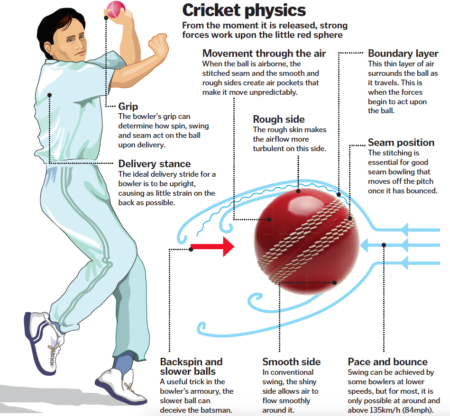Cricket-ball physics
The movement of a cricket ball is unique within the sporting world. When the ball is delivered, a layer of air known as a ‘boundary layer’ forms over the ball. This is where the physics come into play. By angling the seam – the stitched part in the middle – the bowler can alter the pressure of the forces on the ball and choose which way the delivery will go. The aerodynamics can be varied further by the bowler changing the pace of the ball and where the ball bounces. These deliveries are known as ‘cutters’ to cricket fans and the practice is called seam bowling. Spin is another weapon in the bowler’s armoury. Spin bowlers use their wrist or fingers to put revolutions on the ball to allow it to spin fiercely once it has pitched. Slow spin works better on dry and dusty pitches where the ball can skip off the pitch. Side forces also act on the ball in swing bowling. When one side of the ball becomes rougher than the other, that half becomes less streamlined. Bowlers frequently use this to their advantage to move the ball sideways in the air in order to confuse batsmen into playing false and poorly timed shots. The effect of swing can be exaggerated even further by shining one side of the ball, although using anything other than your cricket whites to rough the ball up is considered unsporting.
The mystery of reverse swing
Reverse swing, where the ball swings in the opposite direction to the conventional way, is a rare delivery that can dismiss even the most experienced batsmen. Made famous by the likes of Wasim Akram and Imran Khan, the cricket ball can become almost unplayable. Readily achievable at bowling speeds of over 135 kilometres (84 miles) per hour, reverse swing works best when the ball is old and rough. Now the ball is not shiny so it will move in the opposite way to what is expected from a conventional swing. The boundary layer is affected quicker, allowing an in-swinging bowler to bowl out-swinging deliveries and vice-versa. As the bowler doesn’t change his grip, there is no hint to the batsman that the ball will move the other way. It is said that overcast and humid weather can aid swing bowling, but further research into this remains inconclusive. If a bowler masters reverse swing, the odds will be in his favour.
DID YOU KNOW? The fastest delivery bowled was 161.3 km/h (100.2mph) by Pakistan’s Shoaib Akhtar at the 2003 Cricket World Cup
For more information about science and technology, visit our website now. If you have a tablet or smartphone, you can also download the latest digital version onto your iOS or Android device. To make sure you never miss an issue of How It Works magazine, subscribe today!
Other articles you might like:






